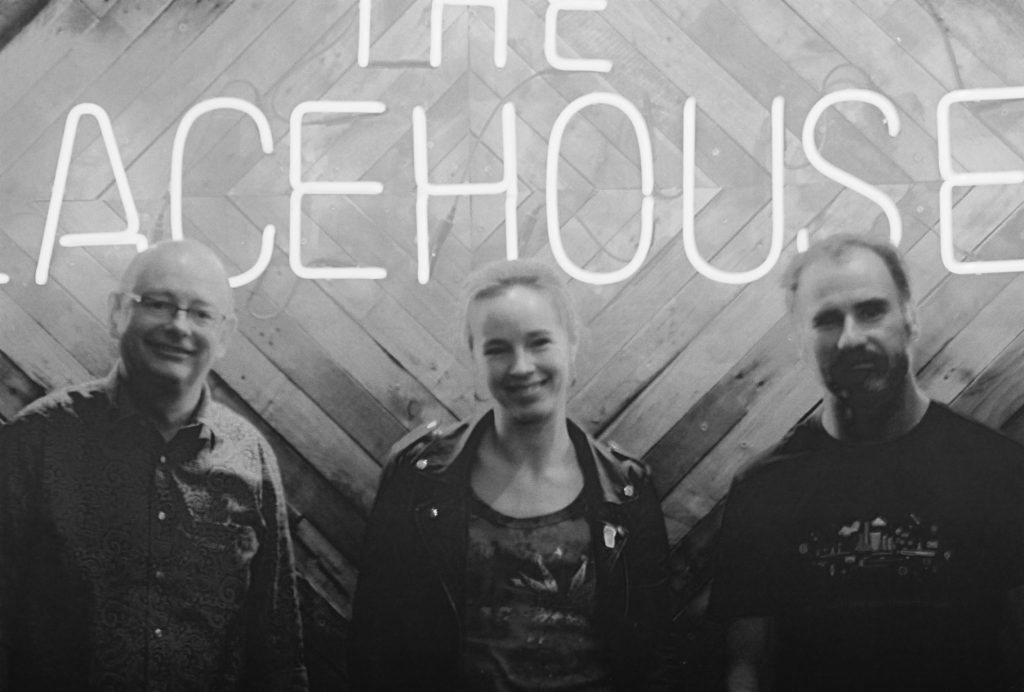May 25, 2018, by Prof Meghan Gray
From Baryon to Byron: reflections on Creative Reactions 2018
Guest post from Prof Mark Fromhold, who was a featured speaker in this year’s Pint of Science and Creative Reaction festivals held earlier this month in Nottingham.

Nottingham physicists Mark Fromhold, Beatriz Olmos Sanchez, and Philip Moriarty were the speakers for “The Quantum World” event at this year’s Pint of Science Festival (credit: Jak Andrukowicz-Kearns)
A joy of spring is the annual Pint of Science festival, where scientists present their work to a public audience in a public house. Recently, the festival added Creative Reactions events comprising exhibits, typically painting, sculpture, or photographs, by artists who are twinned with scientists whose work they portray. This year, I was paired with performance poet Claire Guest, who, in addition to being Birmingham’s first Young Poet Laureate, recently completed a degree in Chemical Engineering. Claire’s ability to cross oft-perceived boundaries between subjects resonates with my view of human activity as a continuum and provided a platform for us to challenge the stereotypical Arts-Science divide.
When I first heard Claire perform, I was hugely impressed by the way that she shapes the dynamics of sentences to emphasise their meaning. In discussion, we realised that we both seek to control flow: Claire modulates the delivery of words and, with colleagues, I tailor current paths to mould magnetic fields. This common ground helped us to translate physics, and the act of doing it, into poetry. There are other profound connections between art and science. The emission spectra of atoms, and the underlying quantum standing waves, have analogies with the tonal characteristics of music instruments: in the optical orchestra plutonium is to the bass drum as hydrogen is to the flute.
For the first time, this year’s Creative Reactions included both physical pieces and performances: Claire’s poetry and a dance on the theme of addiction choreographed by Nottingham’s Hal Mayer. Sandwiched between them, I spoke about the scientific background to Claire’s poem, how we communicated, and the influences that made me a physicist who loves the arts. Preparing the talk was tremendous fun and illuminating. It revealed connections between different phases of my scientific development, and the way that art influenced them, that I had previously missed.
Finally, we have the extremely talented @ClaireGuestPoet performing her work based on the research of @MarkFromhold – whew, we’ve had a FAB night! @creativerxns @pintofscience #pint18 #Nottingham #getphysical pic.twitter.com/f6hrXcYsOb
— STEM Outreach Notts (@STEM_ON_Notts) May 14, 2018
My dad was a railway signalling engineer who painted and made things: hand-wound motors, lathes from washing machine drives, amplifiers, an oscilloscope, often from discarded parts. Aged around 5, I was drawn to the beauty of his resistors, with their spectral colour bands, monochrome blue or yellow capacitors, and the orange glow of thermionic valves. I loved watching him solder them together to make them do something. Sometimes that something seemed magical, like the green tangoing trace on his oscilloscope screen, which was transplanted from a railway signal and wrote my heart beat. Early biomedical imaging; an activity that I revisited as a hospital physicist and, more recently, through the UK Quantum Technologies programme. That oscilloscope has sat in my office since my dad died in 2013. The weekend before Creative Reactions I took it home and cranked it up. To my joy the trace glowed again for the first time in decades and confirmed that, almost 50 years after I first checked, I still have a pulse. A video of that pulse joined my talk together with Nicola Clare’s electrical component painting Resistor 2 and nail decorations made from printed circuit boards and components. Fashion, at last, meets physics.
For the first time in at least 6 years I have powered up the valve oscilloscope that my dad made. Wonderfully, it still works. The display is from an old railway signal box. pic.twitter.com/ZiYXOvNXJZ
— MarkFromhold #FBPE (@MarkFromhold) May 12, 2018
There were confessions too. Like telling the audience that I like the smell of glowing valves. Also that, for Valentine’s Day, I once bought my wife a diffraction grating. Though dull in the hand, each autumn and spring it floods our kitchen with sun spectra.
Art conveys meaning when words fail to. Whilst working with Claire, I came across a tattooist’s work, in which patterns represent letters. Seen one way the letter spell “wave”, but view askew, “particle” dominates, elegantly capturing the concept of duality. A theme of Claire’s poem was how to understand such counter-intuitive concepts that defy visualisation. She found solace in Feynman’s advice that, where quantum weirdness is concerned, we should “Shut up and calculate !”
Giant quantum waves, Laser cooling, Superatoms and Atom chips. Wave-Particle duality underpins almost all of our modern-day technologies. An amazing talk from Professor Mark Fromhold! @pintofscience @Hindawi #quantumleap #atg #pint18 pic.twitter.com/FNapEevy0v
— STEM Outreach Notts (@STEM_ON_Notts) May 15, 2018
It was a privilege and a pleasure to be involved with Pint of Science and Creative Reactions. Speaking after vaping dancers and before a performance poet is exciting and energising. Most of all, I was impressed by the tremendous work done, over many months, by more than 60 University of Nottingham students to organise and run a flawless festival. I hope they’ll have me back next year. Maybe I’ll even get twinned with the tattooist.
No comments yet, fill out a comment to be the first

Leave a Reply